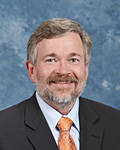How do we solve big science problems using all the modern tools and technologies at our fingertips?
Category
Published on
Abstract
The new Summit supercomputer provides unprecedented opportunity to perform modeling and simulation and artificial intelligence at a scale that is an order of magnitude greater than prior supercomputer systems. Exascale is on the horizon and ORNL just announced our next new system called Frontier to be delivered in 2021 – another order of magnitude more powerful! I will discuss the technologies used in Summit and Frontier. I will also talk about how, over the past couple of decades, supercomputers have changed the way we conduct science in the national lab complex. I will give examples of how integrating supercomputers, artificial intelligence, experiments, and new theories help to solve the nation’s largest science problems.
Bio
 Dr. Nichols became the associate laboratory director for ORNL’s Computing and Computational Sciences in April 2009. In this position, he oversees the Department of Energy’s (DOE) National Center for Computational Sciences (NCCS), the site of the Oak Ridge Leadership Computing Facility (OLCF), which delivers state-of-the-art scientific research and technological innovations. The OLCF is home to Summit, the world’s most powerful computing resource. Nichols also leads ORNL’s agenda in advanced high-performance computing in priority areas such as materials science, fusion energy, and health data, as well as the laboratory’s quantum computing and artificial intelligence initiatives.
Dr. Nichols became the associate laboratory director for ORNL’s Computing and Computational Sciences in April 2009. In this position, he oversees the Department of Energy’s (DOE) National Center for Computational Sciences (NCCS), the site of the Oak Ridge Leadership Computing Facility (OLCF), which delivers state-of-the-art scientific research and technological innovations. The OLCF is home to Summit, the world’s most powerful computing resource. Nichols also leads ORNL’s agenda in advanced high-performance computing in priority areas such as materials science, fusion energy, and health data, as well as the laboratory’s quantum computing and artificial intelligence initiatives.
Prior to assuming his new position, Dr. Nichols was the deputy associate laboratory director of Computing and Computational Sciences, where he led efforts to build, install, and deploy next‑generation supercomputers for DOE, the National Science Foundation, and the Department of Defense. A theoretical chemist and software developer, Dr. Nichols joined Oak Ridge National Laboratory in 2002 as the director of the Computer Science and Mathematics Division, a position which he held until 2009. From 2005-2006, he was Acting Director of NCCS. Before coming to ORNL, he led the Environmental Molecular Sciences Laboratory at DOE’s Pacific Northwest National Laboratory, where high priority was given to the development, deployment, and use of scalable computational science community codes to solve grand-challenge problems crucial to the nation.
Sponsored by
Cite this work
Researchers should cite this work as follows:
Time
Location
Room 1001, Birck Nanotechnology Center, Purdue University, West Lafayette, IN